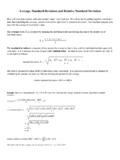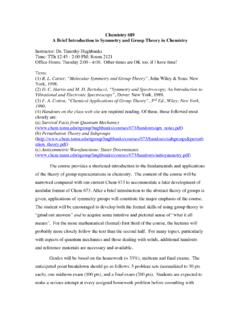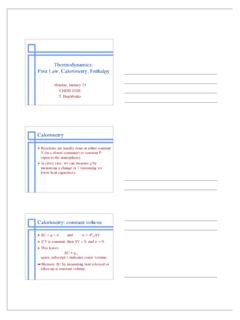Transcription of Ziegler-Natta polymerization of olefins - …
1 Ziegler-Natta polymerization of olefins - stereoselectivity CHEM 462: Inorganic/Organometallic Chemistry Haomiao Xie & Xu Ye Professor: Dr. Marcetta Y. Darensbourg 1 Outline 1. Introduction of polymerization and history of Ziegler-Natta Catalysts. Overview of polymer and polymerization . coordination polymerization and Ziegler-Natta Catalysts 2. Mechanism of Ziegler-Natta polymerization . The Cossee Mechanism The Green-Rooney Mechanism The evidence supporting the Cossee Mechanism 3. Effect factor of Ziegler-Natta polymerization Effect factors of 1,2-insertion Effect factors of beta-elimination 4. stereoselectivity of Ziegler-Natta Catalysts Categories of Stereoselective Ziegler-Natta Catalysts Mechanism and effect factors of Stereoselective Ziegler-Natta Catalysts 5.
2 Conclusion 2 Outline 1. Introduction of polymerization and history of Ziegler-Natta Catalysts. Overview of polymer and polymerization . coordination polymerization and Ziegler-Natta Catalysts 2. Mechanism of Ziegler-Natta polymerization . The Cossee Mechanism The Green-Rooney Mechanism The evidence supporting the Cossee Mechanism 3. Effect factor of Ziegler-Natta polymerization Effect factors of 1,2-insertion Effect factors of beta-elimination 4. stereoselectivity of Ziegler-Natta Catalysts Categories of Stereoselective Ziegler-Natta Catalysts Mechanism and effect factors of Stereoselective Ziegler-Natta Catalysts 5. Conclusion 3 Overview Polymer: large molecule, composed with many repeated subunits. Use: Natural: DNA, protein Artificial: polystyrene, polyvinyl chloride (PVC) #mediaviewer/ 4 Artificial Polymer Products World's demand for PE and PP Callais, P.
3 Outlook for PE and PP Resins. 16th Annual Canadian Plastics Resin Outlook Conference. Available online: 6 Overview polymerization reaction Step growth: polymers formed by the stepwise reaction between functional groups of monomers Chain growth: linking together of molecules incorporating double or triple carbon-carbon bonds. radical addition polymerization cationic addition polymerization anionic addition polymerization Coordination polymerization (olefin binding/alkyl insertion) 7 Coordination polymerization and Ziegler-Natta Catalysts Coordination polymerization : an addition polymerization in which successive monomers are added to the organometallic active center. Examples are: ROMP (Ring open metathesis polymerization ) polymerization catalyzed by Ziegler-Natta catalyst polymerization catalyzed by Late Transition Metal Complexes catalyst 8 Ziegler-Natta Catalyst: History 1953 Karl Ziegler polymerizes ethene into high MW-HDPE (high density polyethylene) with catalyst based on TiCl4, and Et2 AlCl as co-catalyst.
4 Giulio natta , utilizes Ziegler s catalyst to produce PP. 1963 Ziegler and natta are awarded the Nobel Prize 1973 2nd generation Ziegler-Natta catalysts introduced with TiCl3 purple phases at lower temperatures. 1975-1978 3rd generation catalysts supported on MgCl2 commercialized by many companies. 1977-1980 Kaminsky and Sinn discover high activity metallocene single-site catalysts (SSCs) using methylaluminoxane (MAO) as co-catalyst. 1991 Fourth generation Ziegler-Natta catalysts based on aluminium-oxane activated metallocene complexes used. 1997 Montel (or Lyondell Basell) commercialize PP based on 5th generation Ziegler-Natta catalyst that use , and succinate as donors. A. Shamiri, M. H. Chakrabarti, S. Jahan, M. A. Hussain, W. Kaminsky, P. V. Aravind and W. A. Yehye, Materials 2014, 7, 5069-5108.
5 9 Nobel Prize: 1963 10 Giulio natta - Facts". Nobel Media AB 2014. Web. 17 Nov 2014. < > Prize motivation: "for their discoveries in the field of the chemistry and technology of high polymers" Giulio natta , Italy Karl Ziegler, Germany 1. A. Shamiri, M. H. Chakrabarti, S. Jahan, M. A. Hussain, W. Kaminsky, P. V. Aravind and W. A. Yehye, Materials 2014, 7, 5069-5108. Single Site Metallocene Catalysts: Living polymerization 11 Outline 1. Introduction of polymerization and history of Ziegler-Natta Catalysts. Overview of polymer and polymerization . coordination polymerization and Ziegler-Natta Catalysts 2. Mechanism of Ziegler-Natta polymerization . The Cossee Mechanism The Green-Rooney Mechanism The evidence supporting the Cossee Mechanism 3. Effect factor of Ziegler-Natta polymerization Effect factors of 1,2-insertion Effect factors of beta-elimination 4.
6 stereoselectivity of Ziegler-Natta Catalysts Categories of Stereoselective Ziegler-Natta Catalysts Mechanism and effect factors of Stereoselective Ziegler-Natta Catalysts 5. Conclusion 12 The Cossee Mechanism , ,1964,3,80 and and , ,1964,3,99 MCH2P+RLigand associationMCPR1,2-insertionMCRMRH2 CPHHPHHB rookhart, M.; Green, M.; Wong, L. L. Prog. Inorg. Chem. 1988,36, 1-124. Brookhart, M.; Volpe, A. F., Jr.; Lincoln, D. M.; Horva th, I. T.;Millar, J. M. J. Am. Chem. Soc. 1990, 112, 5634- 13 The Green-Rooney Mechanism , , , Green, and Mahtab, J. Chem. Soc, Chem. Commun., 1978, 604 Green, Pure Appl. Chem., 1978,100,2079 14 Chain Termination and Chain Transfer Steps 15 Kinetic Isotope Effect kH > kD D2 CCD2+H2 CCH21:1Cp2(Et)(Cl)Ti/EtAlCl2CH3CH2(CX2CX 2)nHX= H, DH:D = 1 , , and Grubbs, J. Am.
7 Chem. Soc. , 1982,104,4479 Conclusion: Lack of KIE indicates no C-H bond breaking in RDS 16 Kinetic Isotope Effect, continued 17 , , , ,and , J. Am. Chem. Soc.,1985,107,3377 Cp2 TiClHDAlHCp2 TiClHDAlHCp2 TiClHAlHDHHClAlHCp2Ti12 HHClAlHCp2Ti12 Product Ratio is 1:1"Cis""trans"Cp2 TiClDHHAlCp2 TiClDAlHHCp2 TiHClDAlHHGreen-Rooney Mechanism , , , ,and , J. Am. Chem. Soc.,1985,107,3377 "Stereochemical" Isotope Effect Cp2 TiClHDAlHCp2 TiClHDAlHHDClAlHCp2Ti12 HDClAlHTiCp212 Product Ratio is 1:1"Cis""trans"Cp2 TiClDHHAlCp2 TiClAlHHCossee Mechanism Conclusion: Cossee Mechanism Negative results of Kinetic Isotope Effect excludes Green-Rooney Mechanism "Stereochemical" Isotope Effect shows the Cossee Mechanism is reasonable 19 Outline 1. Introduction of polymerization and history of Ziegler-Natta Catalysts. Overview of polymer and polymerization .
8 Coordination polymerization and Ziegler-Natta Catalysts 2. Mechanism of Ziegler-Natta polymerization . The Cossee Mechanism The Green-Rooney Mechanism The evidence supporting the Cossee Mechanism 3. Factors that Affect Ziegler-Natta polymerization Effects on 1,2-insertion Effects on -elimination 4. stereoselectivity of Ziegler-Natta Catalysts Categories of Stereoselective Ziegler-Natta Catalysts Mechanism and effect factors of Stereoselective Ziegler-Natta Catalysts 5. Conclusion 20 LnMHH2 CCH2 LnMHCH2H2 CLnMH2 CCH2 HInsertion -Elimination 1,2-insertion and -Elimination LnMRH2 CCH2 LnMRCH2H2 CLnMH2 CCH2R21 CHd- * Interaction Stabilizing factor Ti(IV),Zr(IV),V(V): d0 Late Transistion Metal: Ni(II) d8 OPPhPhNiHOPPhPhNiODynamically stable lower Ea for -Elimination Catalysts for polymerization Shell Higher Olefin Process(SHOP) Electronic Characteristics of Early and Late Transition Metals in Olefin polymerization /Oligomerization Catalysis Catalysts for Oligomerization -elimination favored for Ni, yielding short chains 22 NNNiBrBrNNPdOMeOBulky diimine groups impede the -Elimination , , and M.
9 Brookhart,J. Am. Chem. Soc.,1995,117,6414 23 Electronic Effect of -Elimination Spaleck, W.; Antberg, M.; Rohrmann, J.; Winter, A.; Bachmann,B.; Kiprof, P.; Behm, J.; Herrmann, W. A. Angew. Chem., Engl. 1992, 31, 1347-1350. 24 Bond Energy of M-C and M-H 3rd row > 4th row> 5th row 1,2-insertion : Ti < Zr < Hr Ni< Pb < Pt -Elimination: Ti > Zr > Hr Ni > Pb > Pt Effect of Metal 25 Outline 1. Introduction of polymerization and history of Ziegler-Natta Catalysts. Overview of polymer and polymerization . coordination polymerization and Ziegler-Natta Catalysts 2. Mechanism of Ziegler-Natta polymerization . The Cossee Mechanism The Green-Rooney Mechanism The evidence supporting the Cossee Mechanism 3. Effect factor of Ziegler-Natta polymerization Effect factors of 1,2-insertion Effect factors of beta-elimination 4.
10 stereoselectivity of Ziegler-Natta Catalysts Categories of Stereoselective Ziegler-Natta Catalysts Mechanism and effect factors of Stereoselective Ziegler-Natta Catalysts 5. Conclusion 26 Designation of polymer stereotype "m" for meso "r" for racemic Geoffrey W. Coates, Chem. Rev. 2000, 100, 1223-1252 1223 27 Characterization of tacticity Method: solubility X-ray diffraction IR spectroscopy thermal properties NMR (Most Important) (a) methyl region of the 13C NMR spectrum of atactic polypropylene (b) Simulated 13C NMR spectrum by using -gauche effect James E. Mark , Physical properties of polymers handbook , 2nd New York : Springer , 2007 ,page 359-384 28 Isotactic polymerization C2v : Cp2 MCl2 only atactic polypropylene or End Control Cp2 TiPh2 ; (iPrCp)2 TiCl2 isotactic or syndiotactic (temperature dependent) C2 Catalysts most successful : Ligand with a bridging group --rigid structure 29 MClClGeoffrey W.
















